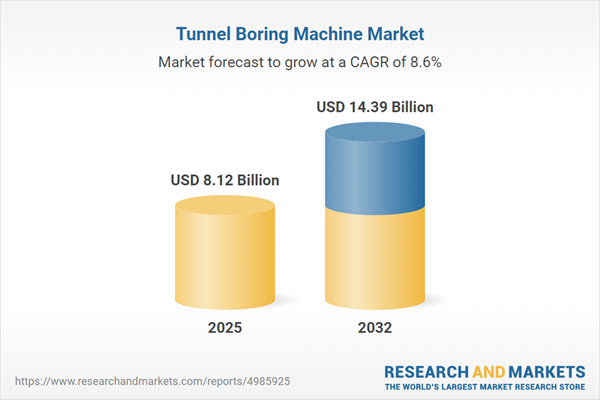Speak directly to the analyst to clarify any post sales queries you may have.
The tunnel boring machine market is undergoing significant transformation, shaped by advances in technology, changing regulatory frameworks, and the growing demands of global infrastructure projects. This executive summary distills the core themes senior decision-makers need to navigate complex procurement, implementation, and long-term strategy in this rapidly evolving sector.
Market Snapshot: Tunnel Boring Machine Market Growth and Outlook
The tunnel boring machine market grew from USD 7.46 billion in 2024 to USD 8.12 billion in 2025. It is expected to continue expanding at a CAGR of 8.55%, projecting to USD 14.39 billion by 2032. This trajectory is driven by investments in urban transit, utilities, and hydropower, underpinned by an increasing need for advanced, efficient underground construction solutions. Senior leaders must respond to shifting project parameters, stakeholder requirements, and global supply chain considerations as demand consolidates across established and emerging regions.
Scope & Segmentation
This report covers the tunnel boring machine market by detailed industry segmentations, providing clear visibility for strategic planning and investment:
- TBM Types: Double Shield, Earth Pressure Balance (for both hard and soft ground), Open TBM, Single Shield, Slurry Shield (with bentonite slurry or sand slurry).
- Applications: Hydropower, Metro, Railway, Roadway, Utility.
- Diameter Ranges: 4-6 meters, 6-9 meters, above 9 meters, and below 4 meters.
- End Users: Construction Companies, Government Agencies, Private Developers.
- Geographic Regions: Americas (including North America and Latin America), Europe, Middle East & Africa (EMEA), and Asia-Pacific. Coverage spans regional leaders such as the United States, Germany, China, India, Australia, and developing economies leveraging regional manufacturing hubs.
- Leading Companies: Herrenknecht AG, China Railway Construction Heavy Industry Co., Ltd., The Robbins Company, Mitsubishi Heavy Industries, Ltd., TERRATEC Pty Ltd, Komatsu Ltd., China Railway Engineering Equipment Group Co., Ltd., Lovat S.p.A., Hitachi Zosen Corporation, SELI Overseas S.p.A.
Key Takeaways for Senior Decision-Makers
- Advanced TBM configurations—such as modular, sensor-enabled systems—allow project owners flexibility to adapt equipment to unique geological and operational requirements, enhancing operational predictability.
- Digital twin platforms and predictive maintenance are streamlining lifecycle management, limiting costly unplanned downtime, and supporting long-term sustainability targets.
- Sustainability and environmental mandates prompt greater adoption of electric drives, energy recovery, and reusable materials, particularly in markets with stringent regulatory oversight.
- OEMs are forging alliances with software and component specialists to deepen integration and accelerate value-added services within increasingly digitized project environments.
- Regional manufacturing partnerships are vital in reducing lead times and ensuring compliance with local content guidelines, especially across Asia-Pacific and EMEA.
- Customization of procurement strategies is essential to address shifting policy, trade, and project risks, supporting robust scenario planning and flexible contract design.
United States Tariff Impact
The 2025 introduction of new US tariffs on imported tunnel boring equipment and components has increased complexity in supply chains and capital planning for North American projects. Contractors and project owners are diversifying sourcing, establishing regional assembly, and leveraging partnerships to mitigate tariff exposure. Broader impacts include revised risk management approaches and a stronger focus on contractual resilience to support evolving policy landscapes.
Methodology & Data Sources
This report combines primary research through structured interviews with TBM manufacturers, infrastructure project directors, and procurement experts, along with extensive reviews of technical journals, regulatory documents, and company disclosures. Analytical methods such as Porter’s Five Forces and scenario planning reinforce the reliability of both qualitative and quantitative insights.
Why This Report Matters
- Provides strategic clarity for leaders assessing investment in advanced tunnel boring solutions amid rapid technological change and regulatory evolution.
- Supports project risk management by detailing procurement best practices and supply chain resilience measures relevant to both established and emerging markets.
- Enables benchmarking for competitive positioning and partnership identification, enhancing decision-making across multiple project segments and geographies.
Conclusion
The tunnel boring machine market is poised for sustained growth, propelled by technological modernization, regulatory adaptation, and infrastructure ambitions worldwide. This research offers strategic direction for organizations aiming to maximize opportunity, efficiency, and resilience in the underground construction sector.
Additional Product Information:
- Purchase of this report includes 1 year online access with quarterly updates.
- This report can be updated on request. Please contact our Customer Experience team using the Ask a Question widget on our website.
Table of Contents
3. Executive Summary
4. Market Overview
7. Cumulative Impact of Artificial Intelligence 2025
Companies Mentioned
The companies profiled in this Tunnel Boring Machine market report include:- Herrenknecht AG
- China Railway Construction Heavy Industry Co., Ltd.
- The Robbins Company
- Mitsubishi Heavy Industries, Ltd.
- TERRATEC Pty Ltd
- Komatsu Ltd.
- China Railway Engineering Equipment Group Co., Ltd.
- Lovat S.p.A.
- Hitachi Zosen Corporation
- SELI Overseas S.p.A.
Table Information
| Report Attribute | Details |
|---|---|
| No. of Pages | 194 |
| Published | October 2025 |
| Forecast Period | 2025 - 2032 |
| Estimated Market Value ( USD | $ 8.12 Billion |
| Forecasted Market Value ( USD | $ 14.39 Billion |
| Compound Annual Growth Rate | 8.5% |
| Regions Covered | Global |
| No. of Companies Mentioned | 11 |









